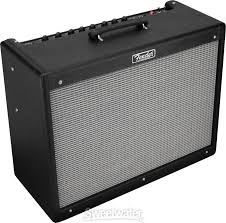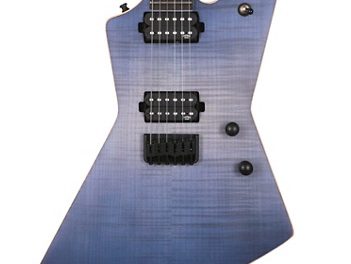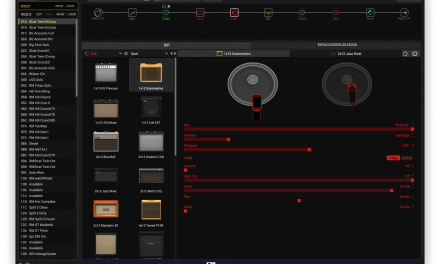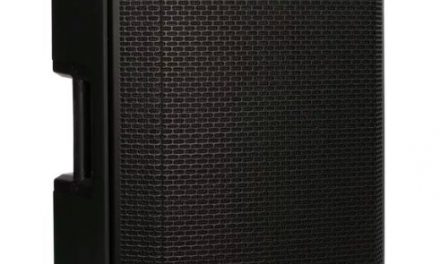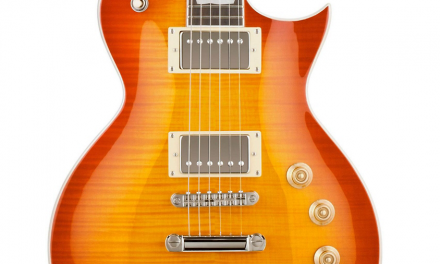Review last updated – 4/16/16
It’s the amp players love to hate or hate to love. And after many years, I finally bought one. The Hot Rod Deluxe III sells for around $729. It’s a 40 watt tube amp with a 12 inch speaker. It has two channels (some say three but no, it’s two) and it uses 12AX7 preamp tubes and 6L6 power tubes. It has a nice sounding old school spring reverb tank. And it is one of the best selling tube amps in the world.
The HRDIII is known for three things: it has a “great” clean sound (maybe,) you can’t put the volume knob above 2 indoors, and the dirty channel is awful. So people buy this thing for the clean sound. I did. Do I regret my purchase? No. How can I justify spending more than $500 on an amp? Well… to me, it was the least expensive great sounding clean sound.
Fender doesn’t make what I actually want, so I bought this instead. What I would love to have is a 15 watt Fender tube amp with good eq, a 12 inch speaker, a great clean sound, and a great dirty sound. If you want a great dirty tone from a Fender, you’re looking at a Supersonic and they’re far more expensive. (Update – Um, except for the new Fender Bassbreaker series, which just came out around the end of 2015, which delivers EXACTLY what I just said. If the 15 watt combo Bassbreaker had been available when I was buying, I’d have bought that.)
But what about the Blues Junior, you ask? I said “great clean sound.” Yes, some love the Blues Junior’s clean sound. I’m not saying that my opinion is worth more than anyone’s. But the Blues Junior sounds like a little box. Because that’s exactly what it is. The HRD III has a bigger cabinet and an open back, and has a big sound that fills a room nicely. Fender made the Super Champ X2 and I did own one, and I did like it, but that’s a 10 inch speaker and it uses digital modeling. They made a few other amps such as the Ramparte, but it sounded small and boxy and the amp had no real EQ. The Princeton Reverb and the Deluxe Reverb are both more expensive.
But let’s keep going. On with the review…
Appearance
This is a good looking amp in my opinion. I can’t lie – I like the tweed look better – but this thing looks like a professional amp, and of course it is. Lots of players gig with one.
Clean
The clean sound is… good? When I bought it, I said it was great. It is a big sound, very full and rich, with nice detail and plenty of spank if you want it. The EQ is very responsive. The spring reverb sounds like it’s supposed to sound. The open back cabinet helps the Celestion 12 inch speaker fill the room with glorious Fender tube amp sound. If you wanted to gig, this amp will easily keep up with any set of drums. Some say the bottom end is flubby. I disagree. I will say that it does not have the same warmth as the Princeton or Deluxe Reverb amps, but it’s close, and it’s cheaper. My Strats sound great through it. A match made in heaven. BUT. I can’t help but feel I’m not getting everything I can out of this amp. The high end isn’t crisp enough, and the mids aren’t warm enough. I’ve lived with it for almost a year, and I’m not loving it. I think this amp is going to be traded in toward a Bassbreaker model of some sort.
Crunch
You’d have to be pretty hard up to say it’s good. If you are really good with the tone knobs, you might get something that’s only simply subpar. See Overdrive…
Overdrive
This amp has the worst overdrive I’ve ever heard. It’s craptacular.
The dirty channel (for both crunch and overdrive) is inexcusable. This is, again, Fender not listening to its own customers. It is almost universally regarded as awful, quite an achievement for the third revision of an amp. Brian Wampler told me the dirty channel sounds bad because it’s hard to make it sound good and keep the price where it is, without making the clean channel sound worse. I believe him. But I can’t help but think that Fender could make at least some improvements to the dirty channel without spending a lot more money on the amp simply with EQ. Regardless, it’s pretty bad sounding. Could you get a reasonable sound out of it for recording? Maybe. On stage, forget it.
Value
Here’s where it gets really difficult. I think the wrong people buy this amp. This amp starts to sound its best when you have it up to 4 or 5. But unfortunately you can’t do that unless you’re in a loud band with a loud drummer. These amps can routinely be found used for around $400 for a reason – you can’t put them above 2 in an average household. Ah, you say, but it has a pre-gain knob. Yes… on the craptacular dirty channel. NOT on the good clean channel. At $400 used, this is a kick ass clean amp. Use your pedals for dirt. Sadly I don’t rate value on used price, and at $729 (or more,) this amp is really only appropriate for gigging musicians who need a very loud amp.
Side Note
This is the third version of this amp and each version has failed to fix the two huge flaws in the product: the awful taper on the volume knob, and the awful sounding dirty channel. Turn the amp up to 2 and it’s as loud as you would want in a house. Probably too loud. You probably have to turn it to about 1 and a half, not an easy thing to do. Players have complained about this for years but Fender hasn’t fixed it. Why not? Because they don’t listen to their customers enough. The workaround is to plug into the second input jack, which is slightly lower in volume than the first one, and get good at finding 1 and a half on the volume pot. Or putting something in the effects loop to bring the signal down, or using a pedal in front of the amp or a volume pedal.

